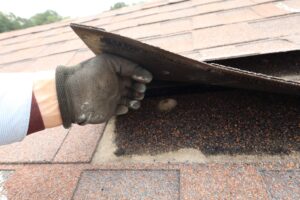You ask, we answer! As part of our limited series, we give you the chance to ask our forensic experts questions about the evaluation of damage to buildings, equipment, and other components of the built environment. Those submitting questions may have their question anonymously posted and answered in our monthly web blog, as below.
Q. What does wind damage to shingle roofing look like?
Shingles are a common roof covering material, especially for residential structures, and evaluation for wind damage to shingles is therefore one of the more frequently requested forensic building evaluations. While there are multiple shingle styles, two styles make up the vast majority of shingles in service: three-tab strip shingles (Figure 1) and laminated strip shingles (Figure 2 – also referred to as “architectural” or “dimensional” shingles).
These shingles are fastened to the roof sheathing, most commonly with nails, and have self-sealing asphaltic adhesive strips (commonly called “sealant strips”) that secure the leading edge (Figure 3). The sealant strip is designed to adhere the overlapping shingles to each other after installation. Therefore, the resistance of the shingles to the effects of wind is provided by the fasteners that anchor the shingle to the roof sheathing and the presence of the sealant strips that seal the shingles together; both the proper shingle nailing and the performance of the sealant strips are important for the wind-resistance of the shingles.

Figure 1. Three-tab shingles with wind damage

Figure 2. Architectural shingles with wind damage
The most obvious wind damage to shingles is when shingles are displaced or missing. This often occurs in patches of shingles along the pattern of shingle installation (often diagonal), as shown in Figures 1 and 2. Other forms of wind-related damage include creasing or tearing of shingles. Wind-related creasing of shingles occurs due to lifting of the corner or edge of the single, with the crease along a line of flexural failure of the shingle (Figure 4).
Tearing of shingles related to wind forces occurs along the line of flexural bending and ultimate failure of the shingle or may occur in a vertical or diagonal pattern due to the detachment of underlying shingles. Small vertical shingle tears without underlying shingle detachment or tearing of shingle corners is typically consistent with installation or distress from shingle manipulation and is not consistent with wind. Investigation of the patterns of distress, or lack thereof, can be critical in determining the extent of wind damage.

Figure 3. View of a shingle’s sealant strip

Figure 4. Shingle creasing and tearing from wind

Figure 5. Vertical shingle tear with no underlying shingle detachment – not related to wind
Nelson’s team of professionals has accrued decades of experience evaluating structures that have been subjected to elevated wind forces, and our team has evaluated thousands of shingle roofs for wind damage and for damages related to other causes.

